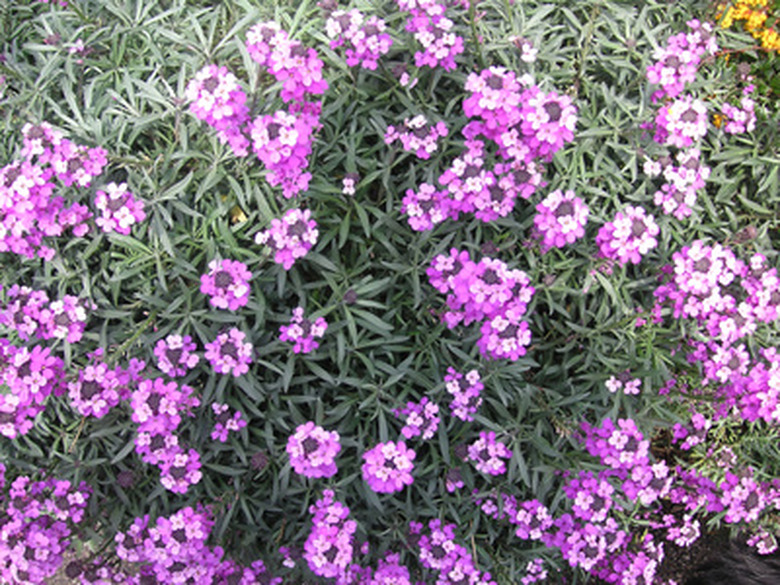Fast-Multiplying Perennial Plants
Perennials are plants and shrubs that return season after season without having to be replanted. Improve bare spaces in the backyard, uninspiring expanses of lawn and unattractive areas near your home by planting fast-multiplying perennials. Some perennials are strong growers in ideal environmental conditions, escaping their original locations, aggressively growing into other areas and even damaging buildings and killing other plants. Prevent aggressive growth with control methods such as planting in submerged containers, regular trimming and removing offshoots and seed heads.
Trumpet Vine
Trumpet vine, commonly called devil's shoestring or trumpet creeper, is a climbing, flowering, vining plant with delicate, lacy green leaves and large trumpet-shaped flowers in red, orange or yellow. Trumpet vine attracts hummingbirds, bees and butterflies, and grows with traveling vines that cover trellises, arbors and fences. Seedlings take 3 to 5 years to get established before flowering, although a sunny location, rich soil and heavy feeding may speed up maturity. In southern climates, trumpet vine is very fast-growing and invasive, crowding out other plants, attaching to and pulling down siding, window frames, gutters and shingles from buildings. It spreads by seeds, growing new plants where vines touch the ground and by sending up many new plants from running underground rhizomes. In northern climates with hard freezes in the winter, trumpet vine is not as invasive but still multiplies quickly. It needs frequent trimming to control wandering vines and mowing around mature woody plants to keep running seedlings from taking over.
- Perennials are plants and shrubs that return season after season without having to be replanted.
- Some perennials are strong growers in ideal environmental conditions, escaping their original locations, aggressively growing into other areas and even damaging buildings and killing other plants.
Ribbon Grass
Ribbon grass is a hardy, fast-growing ornamental grass that grows well in a variety of light, soil and water conditions. It grows only 18 to 24 inches high, with light-green and white-striped spears that grow from a central clump and spread quickly from underground rhizomes. It will multiply rapidly without any special attention and run rampant through flower beds and lawns if not controlled. It is very attractive and easily managed when planted in garden barrels, tubs or containers.
Echinacea
Echinacea, purple cone flower, is a tall-stemmed perennial flower with purple or pink petals around a prickly, raised, cone-shaped center. The green leaves and flower stalks grow from a central rosette. The plants multiply rapidly, with the central rosette growing large, as well as by seeds after flowers have faded. Divide plants in the spring or early fall by splitting the clump with a sharp spade or hand trowel and pulling apart plant and roots to plant separately. With no attention at all, a stand of two or three echinacea plants becomes a large mass of 10 to 20 plants in a few seasons. To prevent seeding, deadhead flowers before they completely dry out.
- Ribbon grass is a hardy, fast-growing ornamental grass that grows well in a variety of light, soil and water conditions.
- Divide plants in the spring or early fall by splitting the clump with a sharp spade or hand trowel and pulling apart plant and roots to plant separately.
Lamb's Ears
Lamb's ears are low-growing ground cover with soft, fuzzy, gray-green leaves that grow from a central rosette. They send up a tall flower stalk with the fragrance of sweet apples that attracts bumble bees and butterflies. Lamb's ears spread rapidly and grow new plants from running underground rhizomes that are very easy to pull up and transplant. The tall flowers shoot thousands of tiny seeds into the surrounding area when dried, sprouting new plants from seed. Lamb's ears will seed nearby lawn areas, producing many tiny whitish green seedlings in the lawn that can be difficult to remove.
References
- "Herbaceous Perennial Plants: A Treatise on Their Identification, Culture, and Garden Attributes"; Allan M. Armitage; 2008
- "Perennials: The Definitive Reference With Over 2,500 Photographs"; Roger Phillips and Martyn Rix; 2008
- "The Perennial Care Manual: A Plant-by-Plant Guide: What to Do and When to Do It"; Nancy J. Ondra and Rob Cardillo; 2009
